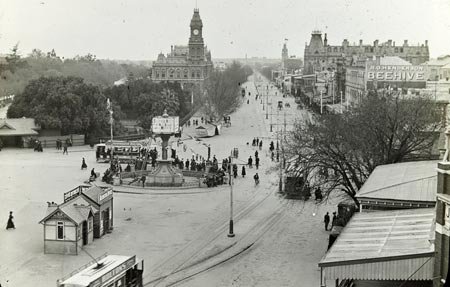By Helen Cronin, Master of Archaeology student
As part of the research for my directed study working on an exhibition of local archaeology, I visited the ceramics consultant who had been at the excavation. The visit revealed the intimate connections between what comes out of the ground and what people remember.
Dennis O’Hoy has long been a champion of local heritage in Bendigo winning the inaugural Ray Tonkin award from Heritage Victoria for volunteer contributions to heritage earlier this year. Now retired, the former Principal Lecturer in ceramics and Head of the Department of Visual Arts at La Trobe University in Bendigo has an encyclopedic knowledge of Chinese, Bendigo Pottery and general ceramics.
It was like asking a child to show you his prized Transformers collection. He showed me photos of the Forest Street excavation (that hadn’t made it into the final report) and DVDs about various digs he’s worked on. Dennis plays a major part in the DVD about the Chinese kiln dig in 2005/6 talking about the Chinese ceramics found on the site. His back shed is crammed with shelves lined with samples of bottles, jars, Chinese and European ceramics – all stored in chronological order, all provenanced, all recorded on a database. It used to be his teaching collection. I thought back to the lab at Port Arthur in January where we were looking at shards of this sort of thing and trying to identify what they were from texts and the lab manager’s extensive knowledge. Dennis has complete samples.
I asked where the ceramics from the Forest Street site were likely to have come from. “Oh, they would have bought them here,” he said, and pulled out a copy of An American on the Goldfields. The book reproduces photos taken by American photographer Benjamin Batchelder during the early 1860s, which are now held by the State Library of Victoria.

Pall Mall Bendigo sometime between 1890 and 1901. The fountain is about a two minute walk from the Forest Street site. The photo is taken around the time of the richest artefact desposits on the site. Source: State Library of Victoria
Dennis took me for a “walk” through Bendigo’s shops. It’s something you can do when you’re both familiar with all the streets and some of the buildings still exist. He showed me where I could buy everything from dinner sets to clothes, fabric and horse gear. We also strolled into the Chinese district where he pointed out the room in building where he was born. It’s no longer there; the buildings were all knocked down in the 1970s and eventually the area become the Chinese (tourist) precinct where the Golden Dragon museum now stands.
“Remember the DVD about the Chinese kiln where I’m talking about the bowl?” he asked. Yes – he’s showing the base of a green glazed bowl excavated from the site and explaining about the trade in Chinese ceramics in the 19th century. On the base of the inside you can see a pink and green flower. On what remains of the outside of the bowl, you can see enough of the design to guess that it decorated the outside as well.
Dennis knelt down and opened a door in an old cabinet in his living room and pulled out a whole sample of the same bowl, complete with small chips on the rim apparently from everyday use. “It came from my grandfather’s shop.”

